yogabuch / asanas / prasarita padottanasana
Contents
- 1 prasarita padottanasana„straddled intensive leg extension“
- 2 Variants
prasarita padottanasana
„straddled intensive leg extension“

 instructions and details with working links as PDF for download/print
instructions and details with working links as PDF for download/print
Feedback: We’d love to hear what you think about this description, give us feedback at:
postmeister@yogabook.org
last update: 30.12.2018
Name: prasarita padottanasana
Trivial name: straddled intense leg stretch
Level: A
- Classification: A
- Contraindication
- effects
- Preparation
- follow-up
- derived asanas
- similar asanas
- diagnostics
- Instruction
- details
- Variants
Classification
classic: standing posture
psychomental: slightly calming
physiological: forward bend, stretching of the hamstrings
Contraindication
In the case of acute disc disease in the lumbar spine, this posture must not be performed as described, but the lumbar spine area must be kept straight, as is the case with sufficient flexibility of the ischiocrural group in the hands supported variant. In this variant, care must be taken to ensure that the lumbar spine does not hyperlordosis in the event of facet syndrome, spondylolisthesis (spondylolisthesis) or spinal canal stenosis if the ischiocrural group is sufficiently mobile.
Effects
- (311) Stretching the biceps
- (312) Strengthening of the biceps
- (331) Stretching for pronation of the forearm
- (511) Stretching the pectoralis major
- (721) Stretching the hamstrings
- (751) Stretching the adductors
- (871) Stretching the pronators of the ankle
Preparation
The most important preparation is for flexion in the hip joints, i.e. the hamstrings. In principle, standing pre-bends are more effective and less complicated:
- uttanasana as a generally effective and efficient stretch of the ischiocrural group to prepare for flexion in the hip joints in this posture
- parsvottanasana as a stretch that goes beyond uttanasana
- Head down dog is also a good preparation for the ischiocrural group when the pelvis is tilted powerfully
- hip opener 5 as a very effective stretch for the hamstrings that goes beyond uttanasana
- warrior 3 pose
- trikonasana
- parivrtta trikonasana
- parivrtta ardha chandrasana
- supta krouncasana
- krouncasana
Here are a few more seated forward bends:
If the distance between the feet is large, this can lead to a strong stretching sensation in the outer lower legs, especially for runners:
- parsvakonasana as a slightly longer, deeply bent pose with strong supination in the ankle joint of the extended leg to stretch the outer lower legs
- Theke, if it can be held long enough and is bent deeply
- warrior 2 pose, if it can be held long enough and is bent deeply
If the arms are taken behind the back and over the head, the retroversion abilityin the shoulder joint comes into play, which is often quite limited:
- purvottanasana („8 treasures“)
- shoulder stand
- gomukhasana
- „Arms behind the body“ variation of uttanasana
- maricyasana 1
- maricyasana 3
- setu bandha sarvangasana
If, in addition to the hamstrings, other short hip extensors hinder the forward bend, practise:
- half lotus forward bend
- hip opener at the edge of the mat
- hip opener 3
- parivrtta trikonasana
- parivrtta ardha chandrasana
- malasana
- maricyasana 1
- maricyasana 3
Wrap-up
derived asanas:
similar asanas:
Diagnostics (No.)
(880) Hyperextension of the knee joint:
Overextension of the knee joint refers to the ability to or the current state of an angle of more than 180° in the knee joint. To a certain extent, this is considered normal by anatomists and is on average more common and more pronounced in females. However, it can also indicate weakness of the quadriceps or hamstrings. Furthermore, hyperextension often causes unphysiological sensations that are not caused by stretching or exertion of the muscles and should be avoided, see also FAQ.
(861) Lower leg (tearing sensation):
This posture requires a sharp supination in the ankles, especially when there is a large distance between the feet; accordingly, the muscles responsible for pronation are stretched correspondingly vigorously. This often applies to runners and athletes from sports that involve a lot of running movements. In principle, it seems sensible to restore flexibility here too, as it alleviates the consequences of twisting over the outer edge of the foot if there is already good flexibility in this direction. Supination trauma, which can permanently destabilize the ankle joint even if it occurs only once and can later trigger arthrosis in the knee joint as well, then does not occur at all or is less severe.
(650) Kyphosis and lordosis of the spine:
Irregularities in the kyphosis of the thoracic spine are clearly visible when the back is rounded in prasarita padottanasana. If the lumbar spine is not in a position to lift the lordosis, a hyperlordosis of the lumbar spine must be suspected. The hip flexors are then often shortened. Physiologically, this would be an evenly increasing rounding of the back, starting with the lumbar spine and slowly increasing towards the thoracic spine. The exact rounding of the back naturally depends largely on the flexibility of the hamstrings and the resulting effect of gravityon the upper body. See also the FAQ.
(611) Pelvicobliquity/scoliosisof the spine:
The lateral deviations of the spine from the sagittal plane known as scolioses are also quite visible in this posture. See the FAQ.
(852) Calves:
In this pose, the calf muscles are clearly strained, the further the load moves from the heel towards the balls of the feet, the greater the strength endurance demand on the calf muscles (the triceps surae). However, the calf is less prone to cramps in a position where the foot is fully supported and not plantar flexed. If calf cramps occur quickly, this often indicates a lack of strength endurance or a supply problem such as a lack of magnesium in the blood or poor circulation. As a rule, this has nothing to do with calf cramps occurring at night, which are usually caused by sustained stretching movements(plantar flexion) in the ankle due to the current dream event.
(721)(724) Ischiocrural group:
Various disorders can be found in forward bending movements(flexion in one/both hip joints), also under load in the muscles of the back of the leg:
- Shortening of the hamstrings, see FAQ
- Damage to the hamstrings that causes pain or functional limitations can also be easily recognized here, from simple tension to strains to muscle (attachment/detachment/tear). Tears would lead to a reduction in strength when leaving the posture quickly
- Irritation of the sciatic nerve: irritation of the sciatic nerve, which innervates the leg and foot, can become symptomatic during forward bends in particular, even if they are otherwise rather calm. See the FAQ.
- Irritation of the origin of the hamstrings at the ischial tuberosity (at the ischial tuberosities, also known as PHT: proximal hamstring tendinopathy) will be clearly evident in this posture and require protection from intensive stretching, as this posture demands; see the FAQ.
- Baker’s cysts create a feeling of tension or foreign body in the back of the knee, see FAQ.
(729) Biceps femoris:
The biceps femoris is subject to a particular stretching requirement here. Its shortening is often the limiting factor in this posture.
Variants:
Instructions
- Take a straddle position with the distance between your legs approximately equal to your own leg length.
- Bend forward from the hip joints as far as possible and stretch your upper body and head towards the floor. The knee joints remain extended by virtue of the quadriceps and the kneecaps are pulled up.
- Grasp your lower legs above the ankle with your hands and pull yourself downwards, bending your arms outwards.
Details
- If the distance between the legs is large or the person is very mobile, the head may touch the floor. In this case, reduce the distance or pull the head and upper body through the legs as far as possible and tend to pull up again on the other side.
- Take care not to relieve the backs of the legs with residual tension in the lower back, but allow the full force of gravity of the upper body, arms and head to act on the backs of the legs.
- When assuming the position, make sure that you move the pelvis and upper body forward evenly, ideally keeping the upper body stretched for as long as possible.
- Keep the abdominal muscles (rectus abdominis ) soft.
- Make sure that you do not stand too much on the inner or outer edges of the feet, but distribute the pressure evenly. In some cases, especially in athletes, the outside of the lower leg may stretch intensely, especially if the distance between the feet is greater; dose this stretch well. This aspect of the posture can be used to restore flexibility to this part of the lower leg musculature if it has been shortened by sporting activities. It should also offer a certain degree of protection against damage caused by twisting over the outer edge of the foot into incompatible supination(supination trauma). The parsvakonasana has a similar effect.
- Do not allow the legs to twist, but stretch the inner knees in particular strongly backwards; the legs would tend to endorather than exorotate. This contributes a little to the movement of the ischial tuberosities away from each other and facilitates flexion in the hip joints. Distribute the pressure evenly between the inner and outer foot.
- Use the strength of the arm flexors to move the upper body downwards as far as the stretch of the hamstrings in the back of the leg allows. The arms bend to the side. In addition to pulling the lower legs towards the pelvis, you can also pull outwards. In other words, the elbow joints bend and a frontal adduction is performed in the shoulder joints.
- As always, overstretching the knee joints is not desirable and should be avoided, especially if it leads to unphysiological discomfort. The posture can be adopted using the familiar trick: Flex the hip joints to the maximum with the knee joint clearly bent and only then try to straighten the knee joints. If this is not completely possible, it serves its purpose by allowing very intensive stretching of the hamstrings without being able to hyperextend the knee joints.
- In principle, this pose, similar to uttanasana, can lead to a PHT (irritation of the origin of the hamstrings), especially in beginners with a less robust muscular constitution, if it is practiced intensively and repeatedly. If the first sign of this is pain below the ischial tuberosity, follow the recommendations in the FAQ and on the PHT pathology page.
- As in uttanasana and other forward bends, the hip flexion via the muscles of the ischiocrural group, which are placed under tension, that a significant flexion moment occurs in the knee joints. This must be counteracted with force of the quadriceps. The kneecaps are pulled up. However, raised knee caps alone do not mean that the knee joints are stretched. They are only an expression of the tension of the quadriceps, but do not indicate that the stretching moment in the knee joint, which arises from its contraction force, outweighs the flexion moment that the ischiocrural group placed under tension generates.
Variants
Arms behind the back

Effects: (246) Shoulder joint: stretch for retroversion
Instructions
- Take the pose as described above, but do not reach towards the ankles with your hands. Instead, clasp your hands behind your pelvis so that your palms are facing your back.
- Lower your arms as far as possible over your head and back towards the floor. Continue to work on flexing the hip joints with the hip flexors.
Details
- Turn the arms out again. Extend them through the elbow joints, despite any flexion caused by less mobile biceps. Move the wrists apart. Stretch the arms away from the body and leave the muscles at the back of the shoulders soft so that they don’t cramp.
In this variation, the arms behave very unevenly: People with little flexibility are often unable to move their hands far beyond the back because the retroversion ability in the shoulder joints is too limited, meaning that the frontal abductors are not mobile enough. This affects the monoarticular deltoid and coracobrachialis muscles on the one hand, but also the biarticular biceps on the other, as the elbow joint should be in an extended position, which is also the reason for the sometimes pronounced flexion tendency of the elbow joint in this variant. From a biomechanical point of view, the retroverters are therefore passively insufficient. On the other hand, in mobile people the frontal abductor biceps can be so mobile that it does not prevent the elbow joints from hyperextending even in very wide retroversion. - If the hands and arms can hardly be moved away from the back, an assistant can clamp a block between the wrists and back to maintain the position that can be reached.
- If the interlocked fingers slip apart, do not put the fingers together at an angle of less than 180° (in relation to the flexed or palmar side) but at an angle of more than 180° (i.e. from the back of the hand). Bend the fingers wide so that the tips of the same fingers of both hands press against each other. This „finger hooking in pairs“ prevents the hands from slipping apart much better. In this case, the cohesion of the hands generally only depends on the strength of the finger flexors.
- Retroversion in the shoulder joints is often too limited to allow the arms to sink far. If the upper arms at least reach the vertical, a small dumbbell can be gripped with the hands at both ends, which pulls the arms further towards the floor in line with gravity. Be careful not to tip forward, as the dumbbell creates a significant momentum and a significant change in the center of gravity depending on the weight and the angle of the arms.
- If the interlocking of the fingers does not hold well, i.e. the fingers keep „slipping“ apart without hand cream being the cause, finger hooking in pairs helps: do not put the fingers together at an angle of less than 180° between the palms from the sides of the palm but at an angle of more than 180° from the sides of the back of the hand and press together with fingertips of the same length.
- The palms should point towards the back and not away from the back (back of the hand pointing towards the back) because this turns the forearms into supination and thus enables greater exorotation of the upper arms, which in turn has a beneficial effect on the trapezius.
- Alongside the comparable variation of uttanasana and some variations of purvottanasana, this variation is one of the most effective stretches for the arm biceps if the arms extend far enough beyond the vertical.
- If the fingers stretched into each other prove to be too slippery, finger hooking in pairs can help.
wide

This variation allows beginners to tilt the pelvis further forward (into flexion in the hip joints) and use the gravity of the upper body more effectively. At the same time, it can be used by more advanced users to make the outer lower leg more flexible by supinating further and shifting more weight onto the outer foot.
Instructions
- take the pose with a greater distance between the feet and ensure that the outer feet are not relieved but sufficiently loaded.
Details
- Depending on your flexibility, very intense stretching may occur in the fibularis group outer lower leg, often in runners. This variation makes this area more flexible again, reducing the likelihood of damaging the ligaments in the outer foot by accidentally twisting it(supination trauma).
Lateral (parsva)
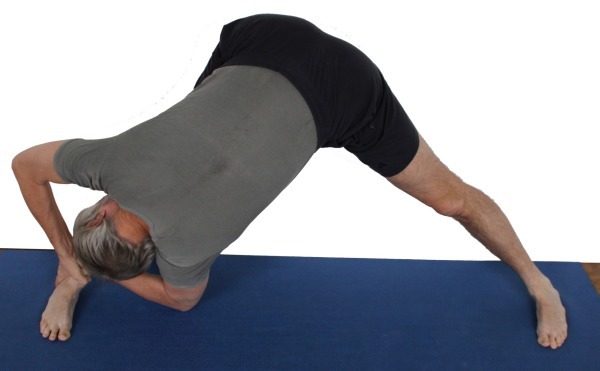
Instructions
- Take the pose as described above.
- Move your upper body towards your right leg and rotate it slightly to the right.
- Grasp the right lower leg above the ankle with both hands.
- Pull the upper body towards the right thigh so that the upper body moves frontally towards the leg in a slight right rotation.
Details
- The upper body makes a lateral flexion and a slight rotation so that the chest cannot be pressed onto the leg in an exactly stretched position.
- Of course, the forehead can be placed on the lower leg if flexibility is good. With even better flexibility, the head can move past the outside of the lower leg.
- Make sure to keep the pelvis straight and not to adduct one leg in relation to the pelvis and abduct the other, which would result in unevenly high hips. However, this can also be done deliberately if the resulting increased stretching of the hamstrings and the fibularis group is desired.
- Due to the asymmetrical design, this pose has a more intensive effect on the hamstrings on one side and possibly also on parts of the lower back or the pomus muscles.
Head down

Instructions
- Take the pose as described above.
- If you are flexible enough, place your head on the floor.
Details
- In this way, prasarita padottanasana becomes a kind of „resting pose“ with reduced stretch in the hamstrings.
Stretching from bent knees

Dealing with irritated origins of the hamstrings on the ischium (PHT).
Instructions
- From a leg-wide straddle, bend the knee joints significantly.
- Tilt the hip joints forwards as far as possible until the upper body is between the thighs.
- Reach for the ankles with your hands and pull on them.
- Slowly extend your legs further, but keep your upper body as low as possible, i.e. your pelvis tilted as far as possible. Ideally, the legs should not be stretched to the maximum extent possible.
Details
- This pose is a little more challenging than the corresponding uttanasana, in which you stretch from bent knee joints, as the upper body cannot be pressed onto the thighs here. However, the principle remains the same and works similarly well, especially as a variation that can often be performed even if there is irritation(PHT) at the origin of the hamstrings on one of the ischialtuberosities (ischial tuberosity). This is also often the treatment of choice in cases of significant or painful hyperextension of the knee joint.
Hands supported
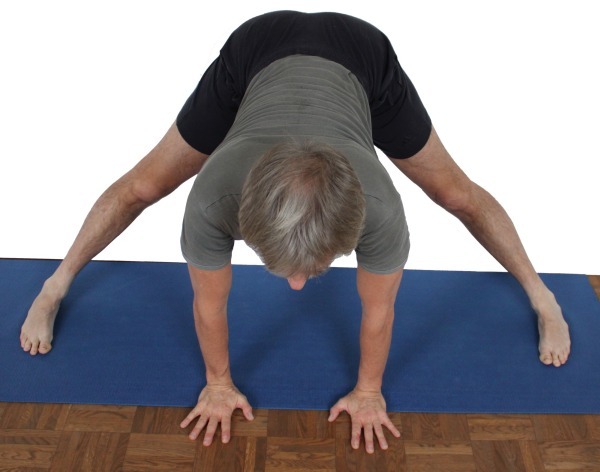
Instructions
- From a leg-width straddle, tilt forward with your back straight at the hips until your upper body is horizontal.
- Place your hands forward under your shoulders, straighten your arms and turn them out.
- Push the hands forcefully in the direction of the line connecting the feet.
- Tilt the hips into maximum flexion so that ideally the spine would be bent backwards.
Details
- In rare cases, you may experience an uncomfortable hollow back in the lumbar spine. It is then best to bend the arms to be able to tilt the upper body further forwards and downwards or, if absolutely necessary, tilt the pelvis slightly out of flexion, which would probably reduce the desired stretch in the back of the leg.
- Raising the head slightly beyond the extension of the thoracic spine would make it easier to stretch the thoracic spine. However, refrain from doing this if you are prone to neck pain.
- This variation corresponds to the uttanasana variation „Table“.
- As in „Table“, the plumb bob should remain between the feet. The arms do not support any significant body weight and only serve to support the stretching movement of the upper body.
- Naturally, the arms are stretched and turned out. The latissimus dorsi and the middle head of the triceps are part of the pose.
- This pose is one of a number of very interesting exercises in which (often very wide) hip flexion is combined with a thoracic spine extension (or an attempt to do so), which simultaneously causes a very intensive stretching of the hamstrings and a strengthening effort of the autochthonous back muscles. It is therefore complementary to the predominantly sedentary behavior of many people, in which the spine is usually excessively convex in this area. Naturally, the shoulder blades are depressed and largely retracted.
Forearms raised
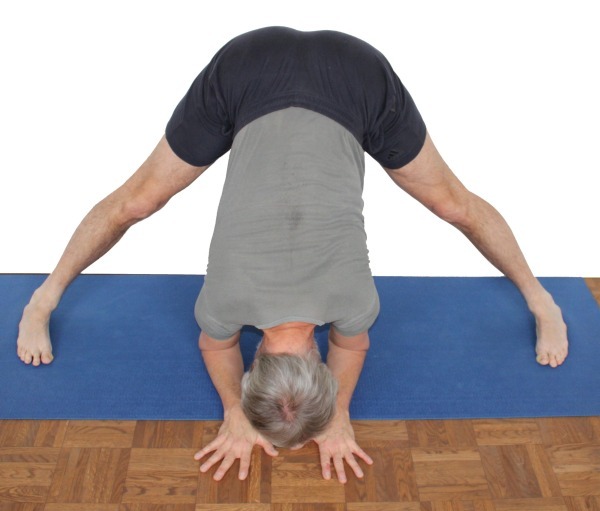
Instructions
- Take the pose as described above.
- Place your forearms on the floor pointing forwards.
- Powerfully push your arms backwards and tilt your hips into flexion as far as possible.
Details
- In rare cases and only with very good flexibility of the hamstrings, you may experience an uncomfortable hollow back in the lumbar spine. In this case, place the elbows at a greater distance from each other in order to be able to tilt the upper body further forwards and downwards, or worse, tilt the pelvis slightly out of flexion, which would probably reduce the desired stretch in the back of the leg.
- Raising the head slightly beyond the extension of the thoracic spine would make it easier to stretch the thoracic spine. However, refrain from doing this if you are prone to neck pain.
- There is no equivalent to uttanasana for this variation.
- As in „table pose“, the plumb bob should remain between the feet. The arms do not support any significant body weight and only serve to support the stretching movement of the upper body.
- The upper arms are turned out wide due to the forearms resting on the floor. The latissimus dorsi and the middle head of the triceps are part of the pose.
- This posture is one of a number of very interesting exercises in which (often very wide) hip flexion is combined with a thoracic spine extension (or an attempt to do so), which simultaneously causes a very intensive stretching of the hamstrings and a strengthening effort of the autochthonous back muscles. Naturally, the shoulder blades are depressed and largely retracted.
with the head raised

Instructions
- Take the pose as described above, but raise your head to be able to stretch the thoracic spine better.
Details
- When the head is raised, the effective lever arm with which the head flexes the thoracic spine is reduced slightly – depending on the flexion in the hip joints – which can lead to more intensive stretching of the hamstrings. At the same time, the muscle tension of the neck/neck does not cause flexion of the thoracic spine, but straightening or even extension. In addition, raising the head slightly improves the extension of the thoracic spine, which in this posture – depending on the flexibility – may also be more or less flexed as a remote effect of the restriction of flexibility of the hamstrings.
- If you are prone to neck complaints or headaches originating from the neck, refrain from raising your head!
Hands placed with bent arms
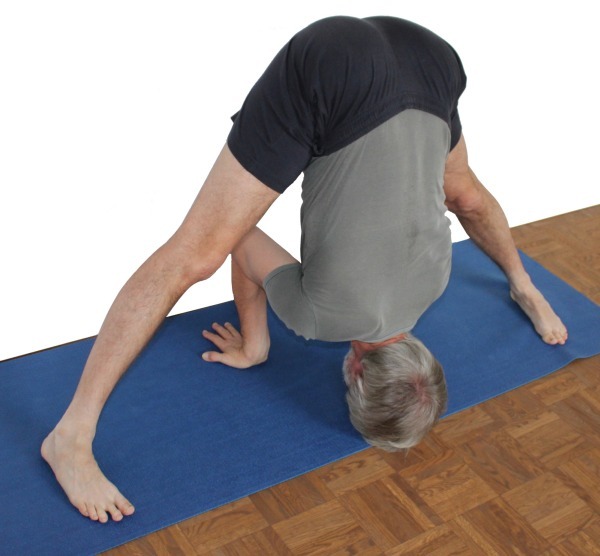
Instructions
- Take the pose as described above, but place the hands behind the line connecting the heels and push them forward against the friction of the mat.
- Bend both arms to pull the upper body further into the forward bend using the strength of the arm flexors.
Details
- Raising the head improves the effective lever arm slightly – depending on the flexion in the hip joints – which can lead to better stretching of the hamstrings.
- The hands can be placed facing forwards or backwards, which has different effects on the shoulder, arm flexors and forearms. If the hands are placed pointing backwards, they must be placed sufficiently far back, as further flexion leads to increasingly uncomfortable angles of dorsal flexion in the wrist. Conversely, if they are placed pointing forwards, they must not be placed too far back, otherwise impossible angles of dorsal flexion in the wrist will occur as soon as the posture is assumed, even if they may become somewhat more favorable in this constellation as the posture progresses. One argument from muscle physiology speaks in favor of the hands pointing backwards: the working range of the biceps in terms of the force-length function is more favorable with the hands positioned slightly further back and pointing backwards than in the other variant. In all cases, the arms should be in vertical parallel planes, which means that they are turned out far, which is favorable for a low tendency of the trapezius to spasm.
(P)
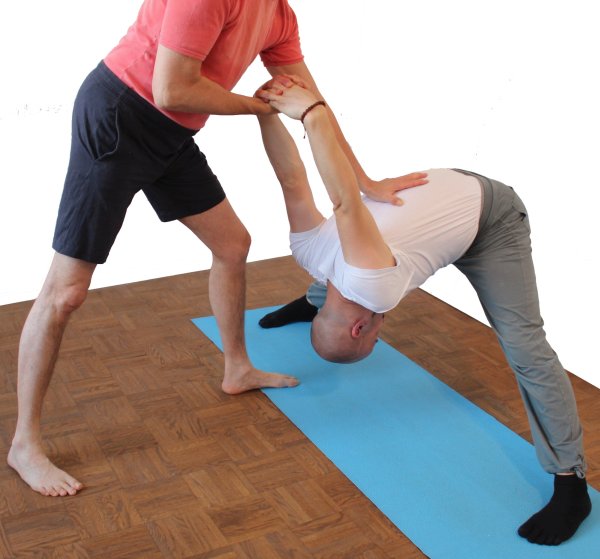
Instructions
- Get into the pose as described above.
- The supporter pulls the performer’s arms away from the back in an arc with one hand on the palms and pushes against the back with the same force with the other hand so that the pelvis remains in flexion.
Details
- Care must be taken here to ensure that the forces applied by the supporter to the performer do not destabilize the posture. The slow build-up and release of force is also important, not only for maintaining stability but also for the muscles: pulling on the hands too quickly could injure the deltoids or biceps, while releasing them too quickly could lead to reflex tension.
(P) on the wall

Instructions
- Perform the partner exercise as described above, but with the performer’s buttocks leaning against a wall, the heels not too far apart, but large enough so that the performer does not topple over.
Details
- In the partner exercise without a wall, the supporter must be careful not to have a detrimental effect on the performer’s stability. This variation remedies this deficiency, the performer can lean against the wall and the supporter can push him firmly against the wall while pulling on the arms.
(S) Back against the wall

Instructions
- Take the pose described above, but stand relatively close to a wall with your feet pointing towards the wall.
- Bend far in the knee joints to be able to move the upper body far forwards and downwards with a hip flexion.
- When your upper body is as low as possible, press your back against the wall and slowly straighten your knee joints.
